Essay: Overview and Analysis of Child-Centred Social Work Practices
VerifiedAdded on 2023/02/03
|11
|3046
|35
Essay
AI Summary
This essay provides a comprehensive overview and critical analysis of child-centred social work practices. It delves into the core principles of engaging children and their families to prevent abuse and neglect. The essay examines the skills, knowledge, and research essential for social workers, emphasizing the importance of understanding child psychology, relevant legislation, and effective communication techniques. It explores the benefits of child-centred approaches, such as enhanced protection and family engagement, while also addressing challenges like inadequate skills and rigid procedures. The essay highlights the significance of active listening, emotional intelligence, and critical thinking in social work, emphasizing the need for social workers to be sensitive and flexible to the needs of children. It concludes by underscoring the importance of continuous professional development and ethical considerations in ensuring the safety and well-being of children.
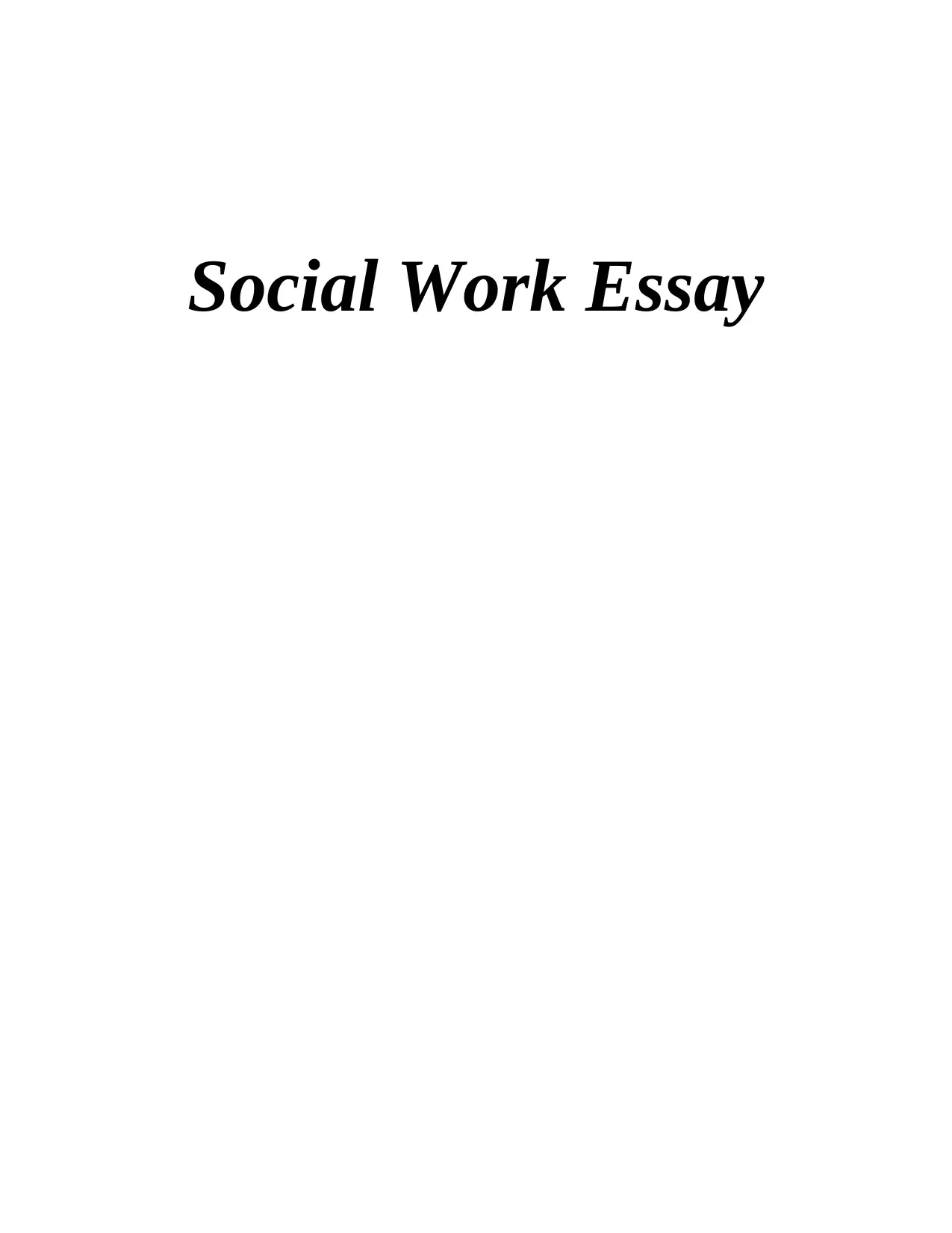
Social Work Essay
Secure Best Marks with AI Grader
Need help grading? Try our AI Grader for instant feedback on your assignments.

Table of Contents
INTRODUCTION...........................................................................................................................1
MAIN BODY...................................................................................................................................1
Overview and critical analysis of child centred social work..................................................1
Skills, knowledge and research of social workers..................................................................3
CONCLUSION................................................................................................................................5
REFERENCES................................................................................................................................7
INTRODUCTION...........................................................................................................................1
MAIN BODY...................................................................................................................................1
Overview and critical analysis of child centred social work..................................................1
Skills, knowledge and research of social workers..................................................................3
CONCLUSION................................................................................................................................5
REFERENCES................................................................................................................................7
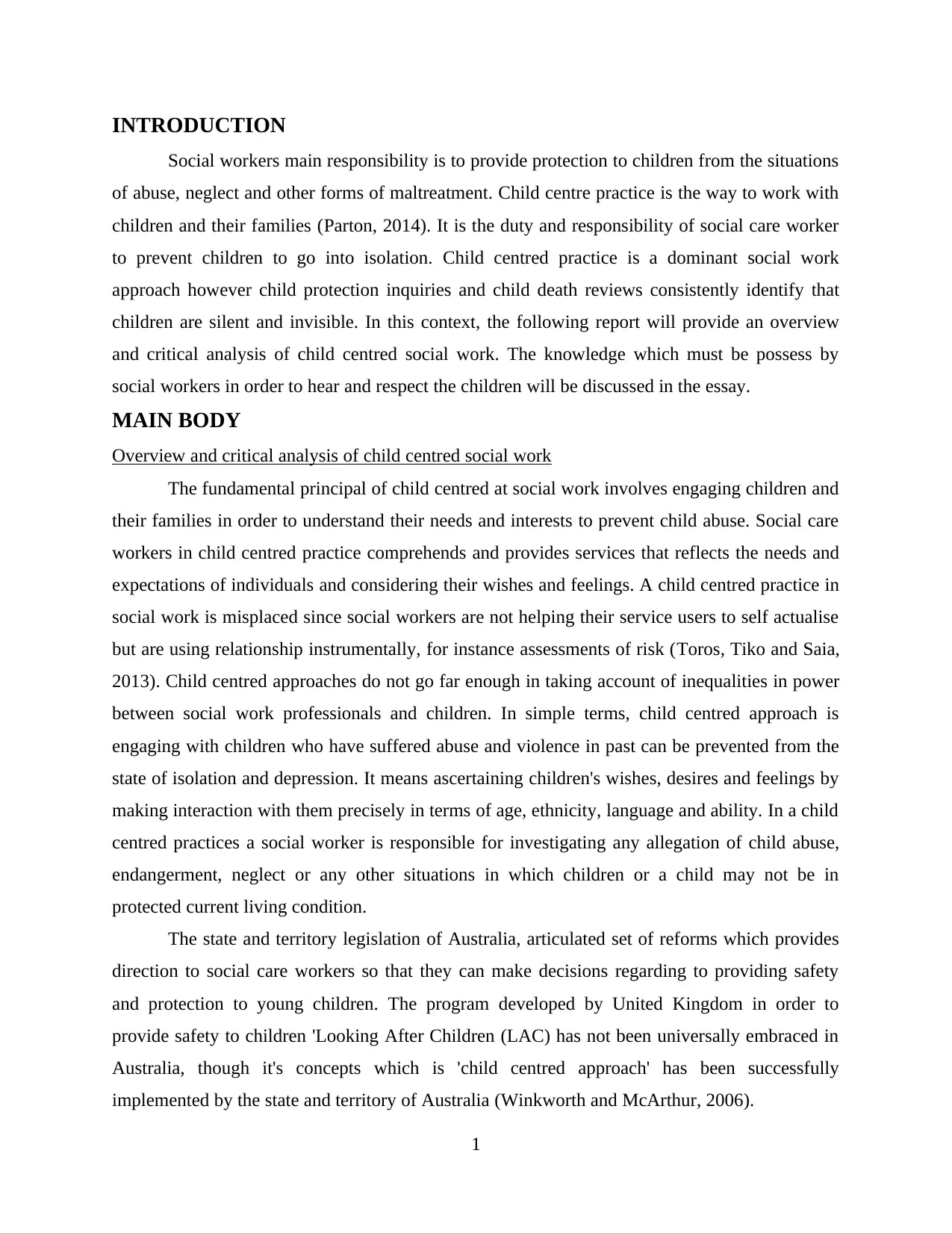
INTRODUCTION
Social workers main responsibility is to provide protection to children from the situations
of abuse, neglect and other forms of maltreatment. Child centre practice is the way to work with
children and their families (Parton, 2014). It is the duty and responsibility of social care worker
to prevent children to go into isolation. Child centred practice is a dominant social work
approach however child protection inquiries and child death reviews consistently identify that
children are silent and invisible. In this context, the following report will provide an overview
and critical analysis of child centred social work. The knowledge which must be possess by
social workers in order to hear and respect the children will be discussed in the essay.
MAIN BODY
Overview and critical analysis of child centred social work
The fundamental principal of child centred at social work involves engaging children and
their families in order to understand their needs and interests to prevent child abuse. Social care
workers in child centred practice comprehends and provides services that reflects the needs and
expectations of individuals and considering their wishes and feelings. A child centred practice in
social work is misplaced since social workers are not helping their service users to self actualise
but are using relationship instrumentally, for instance assessments of risk (Toros, Tiko and Saia,
2013). Child centred approaches do not go far enough in taking account of inequalities in power
between social work professionals and children. In simple terms, child centred approach is
engaging with children who have suffered abuse and violence in past can be prevented from the
state of isolation and depression. It means ascertaining children's wishes, desires and feelings by
making interaction with them precisely in terms of age, ethnicity, language and ability. In a child
centred practices a social worker is responsible for investigating any allegation of child abuse,
endangerment, neglect or any other situations in which children or a child may not be in
protected current living condition.
The state and territory legislation of Australia, articulated set of reforms which provides
direction to social care workers so that they can make decisions regarding to providing safety
and protection to young children. The program developed by United Kingdom in order to
provide safety to children 'Looking After Children (LAC) has not been universally embraced in
Australia, though it's concepts which is 'child centred approach' has been successfully
implemented by the state and territory of Australia (Winkworth and McArthur, 2006).
1
Social workers main responsibility is to provide protection to children from the situations
of abuse, neglect and other forms of maltreatment. Child centre practice is the way to work with
children and their families (Parton, 2014). It is the duty and responsibility of social care worker
to prevent children to go into isolation. Child centred practice is a dominant social work
approach however child protection inquiries and child death reviews consistently identify that
children are silent and invisible. In this context, the following report will provide an overview
and critical analysis of child centred social work. The knowledge which must be possess by
social workers in order to hear and respect the children will be discussed in the essay.
MAIN BODY
Overview and critical analysis of child centred social work
The fundamental principal of child centred at social work involves engaging children and
their families in order to understand their needs and interests to prevent child abuse. Social care
workers in child centred practice comprehends and provides services that reflects the needs and
expectations of individuals and considering their wishes and feelings. A child centred practice in
social work is misplaced since social workers are not helping their service users to self actualise
but are using relationship instrumentally, for instance assessments of risk (Toros, Tiko and Saia,
2013). Child centred approaches do not go far enough in taking account of inequalities in power
between social work professionals and children. In simple terms, child centred approach is
engaging with children who have suffered abuse and violence in past can be prevented from the
state of isolation and depression. It means ascertaining children's wishes, desires and feelings by
making interaction with them precisely in terms of age, ethnicity, language and ability. In a child
centred practices a social worker is responsible for investigating any allegation of child abuse,
endangerment, neglect or any other situations in which children or a child may not be in
protected current living condition.
The state and territory legislation of Australia, articulated set of reforms which provides
direction to social care workers so that they can make decisions regarding to providing safety
and protection to young children. The program developed by United Kingdom in order to
provide safety to children 'Looking After Children (LAC) has not been universally embraced in
Australia, though it's concepts which is 'child centred approach' has been successfully
implemented by the state and territory of Australia (Winkworth and McArthur, 2006).
1

These social workers in child centre practice ensures that decision and plans are
formulated according to children interest. Assessment of risk has to be made in order to enhance
the safety of children (O'Reilly and Dolan, 2016). There are numerous benefits associated with
child centre care approaches utilised by social workers. One of the most significant benefit from
this approach obtain was enhancement in children protection from child abuse and engagement
of family members for support. The core of child centred care approach is to provide assistance
to child by which he or she can become independent, responsible and confident. Social workers
tends to implement this approach in order to cover all the areas of growth and development
including social, emotional and physical. The care providers engage with children by interacting
with them in order to enhance the motivation of child which helps in prevention of isolation of
child. Secondly, child centred practice done by social workers helps in eradicating the risk
factors such as insolent behaviour, fear of people, etc. Thirdly, it improves the relationship
between parents, children (Ferguson, 2016). It is the approach where care providers engage with
both families and children in order to make decision and implements strategies so that child
protection can be enhanced and his or her voice can be heard.
Lack of skills and knowledge in social workers is the first obstruction in providing child
protection and welfare. Social workers must have adequate knowledge regarding legislation,
laws, reforms, principals and policies of child safety (Parton, 2014). Children voice and issues
often remain unheard by the social workers due to inadequate skills and competencies of social
workers. By providing children a voice and a chance to convey any issue concerning themselves
would help in reducing the depressing behaviour in child. Rigid procedures and inadequate
decision making power is considered as another hurdle which impact on child centred practices
provided by the social care workers. Situational analysis must be carried out in order to assess
the ongoing conditions and management needs to transform their policies and reforms
accordingly (Moore, Noble-Carr and McArthur, 2016). This helps both the manager and social
care workers. Australian profession of social works straightforwardly said that social work is
more seen as defining, realising and guaranteeing human rights rather than assessing and meeting
needs of human.
Child centred approach refers to the process where social workers engage with children
in order to assess their need, interest in order to derive precise decision regarding care plan. The
seven dimension of child needs and interests which includes health, identify, social relationship,
2
formulated according to children interest. Assessment of risk has to be made in order to enhance
the safety of children (O'Reilly and Dolan, 2016). There are numerous benefits associated with
child centre care approaches utilised by social workers. One of the most significant benefit from
this approach obtain was enhancement in children protection from child abuse and engagement
of family members for support. The core of child centred care approach is to provide assistance
to child by which he or she can become independent, responsible and confident. Social workers
tends to implement this approach in order to cover all the areas of growth and development
including social, emotional and physical. The care providers engage with children by interacting
with them in order to enhance the motivation of child which helps in prevention of isolation of
child. Secondly, child centred practice done by social workers helps in eradicating the risk
factors such as insolent behaviour, fear of people, etc. Thirdly, it improves the relationship
between parents, children (Ferguson, 2016). It is the approach where care providers engage with
both families and children in order to make decision and implements strategies so that child
protection can be enhanced and his or her voice can be heard.
Lack of skills and knowledge in social workers is the first obstruction in providing child
protection and welfare. Social workers must have adequate knowledge regarding legislation,
laws, reforms, principals and policies of child safety (Parton, 2014). Children voice and issues
often remain unheard by the social workers due to inadequate skills and competencies of social
workers. By providing children a voice and a chance to convey any issue concerning themselves
would help in reducing the depressing behaviour in child. Rigid procedures and inadequate
decision making power is considered as another hurdle which impact on child centred practices
provided by the social care workers. Situational analysis must be carried out in order to assess
the ongoing conditions and management needs to transform their policies and reforms
accordingly (Moore, Noble-Carr and McArthur, 2016). This helps both the manager and social
care workers. Australian profession of social works straightforwardly said that social work is
more seen as defining, realising and guaranteeing human rights rather than assessing and meeting
needs of human.
Child centred approach refers to the process where social workers engage with children
in order to assess their need, interest in order to derive precise decision regarding care plan. The
seven dimension of child needs and interests which includes health, identify, social relationship,
2
Secure Best Marks with AI Grader
Need help grading? Try our AI Grader for instant feedback on your assignments.
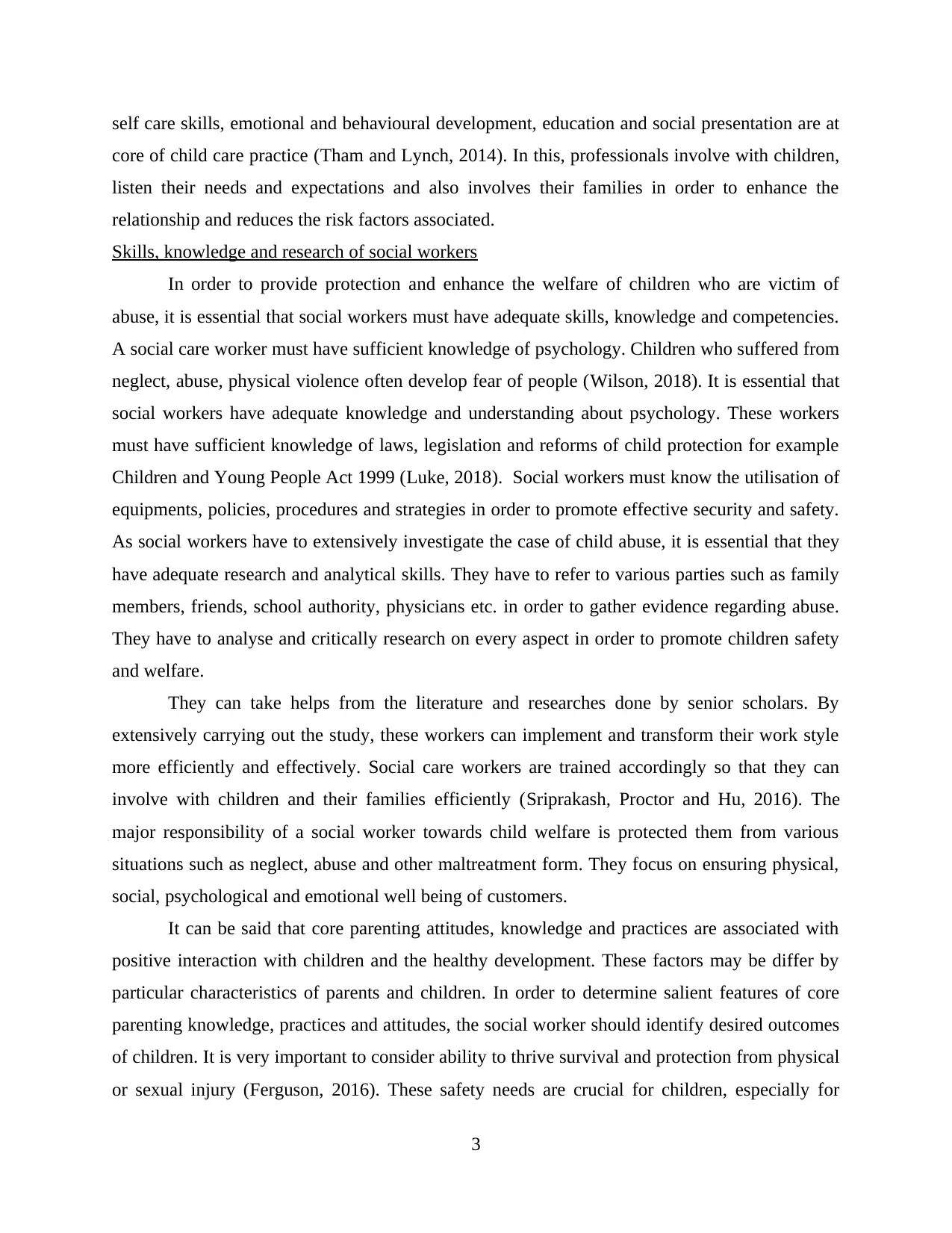
self care skills, emotional and behavioural development, education and social presentation are at
core of child care practice (Tham and Lynch, 2014). In this, professionals involve with children,
listen their needs and expectations and also involves their families in order to enhance the
relationship and reduces the risk factors associated.
Skills, knowledge and research of social workers
In order to provide protection and enhance the welfare of children who are victim of
abuse, it is essential that social workers must have adequate skills, knowledge and competencies.
A social care worker must have sufficient knowledge of psychology. Children who suffered from
neglect, abuse, physical violence often develop fear of people (Wilson, 2018). It is essential that
social workers have adequate knowledge and understanding about psychology. These workers
must have sufficient knowledge of laws, legislation and reforms of child protection for example
Children and Young People Act 1999 (Luke, 2018). Social workers must know the utilisation of
equipments, policies, procedures and strategies in order to promote effective security and safety.
As social workers have to extensively investigate the case of child abuse, it is essential that they
have adequate research and analytical skills. They have to refer to various parties such as family
members, friends, school authority, physicians etc. in order to gather evidence regarding abuse.
They have to analyse and critically research on every aspect in order to promote children safety
and welfare.
They can take helps from the literature and researches done by senior scholars. By
extensively carrying out the study, these workers can implement and transform their work style
more efficiently and effectively. Social care workers are trained accordingly so that they can
involve with children and their families efficiently (Sriprakash, Proctor and Hu, 2016). The
major responsibility of a social worker towards child welfare is protected them from various
situations such as neglect, abuse and other maltreatment form. They focus on ensuring physical,
social, psychological and emotional well being of customers.
It can be said that core parenting attitudes, knowledge and practices are associated with
positive interaction with children and the healthy development. These factors may be differ by
particular characteristics of parents and children. In order to determine salient features of core
parenting knowledge, practices and attitudes, the social worker should identify desired outcomes
of children. It is very important to consider ability to thrive survival and protection from physical
or sexual injury (Ferguson, 2016). These safety needs are crucial for children, especially for
3
core of child care practice (Tham and Lynch, 2014). In this, professionals involve with children,
listen their needs and expectations and also involves their families in order to enhance the
relationship and reduces the risk factors associated.
Skills, knowledge and research of social workers
In order to provide protection and enhance the welfare of children who are victim of
abuse, it is essential that social workers must have adequate skills, knowledge and competencies.
A social care worker must have sufficient knowledge of psychology. Children who suffered from
neglect, abuse, physical violence often develop fear of people (Wilson, 2018). It is essential that
social workers have adequate knowledge and understanding about psychology. These workers
must have sufficient knowledge of laws, legislation and reforms of child protection for example
Children and Young People Act 1999 (Luke, 2018). Social workers must know the utilisation of
equipments, policies, procedures and strategies in order to promote effective security and safety.
As social workers have to extensively investigate the case of child abuse, it is essential that they
have adequate research and analytical skills. They have to refer to various parties such as family
members, friends, school authority, physicians etc. in order to gather evidence regarding abuse.
They have to analyse and critically research on every aspect in order to promote children safety
and welfare.
They can take helps from the literature and researches done by senior scholars. By
extensively carrying out the study, these workers can implement and transform their work style
more efficiently and effectively. Social care workers are trained accordingly so that they can
involve with children and their families efficiently (Sriprakash, Proctor and Hu, 2016). The
major responsibility of a social worker towards child welfare is protected them from various
situations such as neglect, abuse and other maltreatment form. They focus on ensuring physical,
social, psychological and emotional well being of customers.
It can be said that core parenting attitudes, knowledge and practices are associated with
positive interaction with children and the healthy development. These factors may be differ by
particular characteristics of parents and children. In order to determine salient features of core
parenting knowledge, practices and attitudes, the social worker should identify desired outcomes
of children. It is very important to consider ability to thrive survival and protection from physical
or sexual injury (Ferguson, 2016). These safety needs are crucial for children, especially for
3
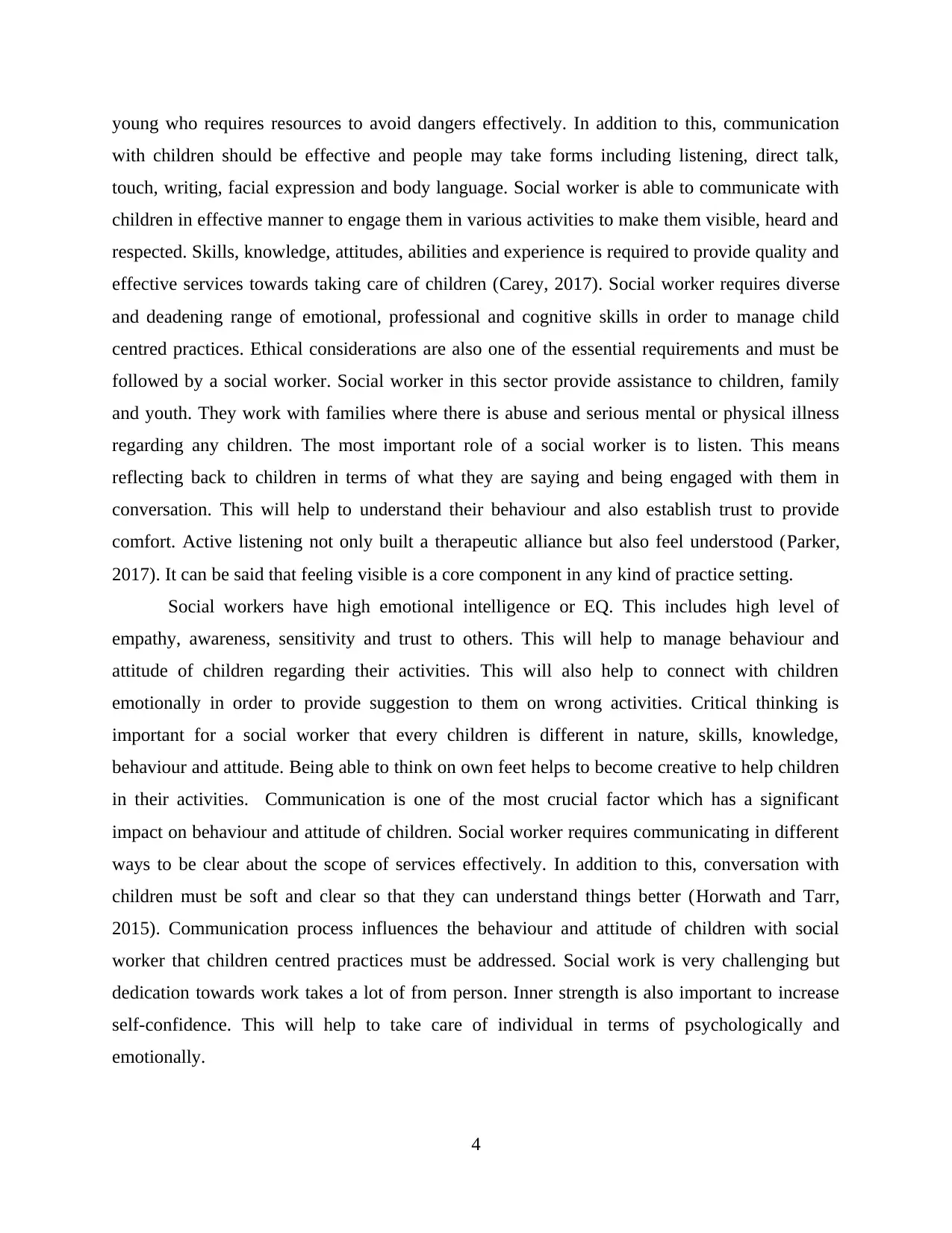
young who requires resources to avoid dangers effectively. In addition to this, communication
with children should be effective and people may take forms including listening, direct talk,
touch, writing, facial expression and body language. Social worker is able to communicate with
children in effective manner to engage them in various activities to make them visible, heard and
respected. Skills, knowledge, attitudes, abilities and experience is required to provide quality and
effective services towards taking care of children (Carey, 2017). Social worker requires diverse
and deadening range of emotional, professional and cognitive skills in order to manage child
centred practices. Ethical considerations are also one of the essential requirements and must be
followed by a social worker. Social worker in this sector provide assistance to children, family
and youth. They work with families where there is abuse and serious mental or physical illness
regarding any children. The most important role of a social worker is to listen. This means
reflecting back to children in terms of what they are saying and being engaged with them in
conversation. This will help to understand their behaviour and also establish trust to provide
comfort. Active listening not only built a therapeutic alliance but also feel understood (Parker,
2017). It can be said that feeling visible is a core component in any kind of practice setting.
Social workers have high emotional intelligence or EQ. This includes high level of
empathy, awareness, sensitivity and trust to others. This will help to manage behaviour and
attitude of children regarding their activities. This will also help to connect with children
emotionally in order to provide suggestion to them on wrong activities. Critical thinking is
important for a social worker that every children is different in nature, skills, knowledge,
behaviour and attitude. Being able to think on own feet helps to become creative to help children
in their activities. Communication is one of the most crucial factor which has a significant
impact on behaviour and attitude of children. Social worker requires communicating in different
ways to be clear about the scope of services effectively. In addition to this, conversation with
children must be soft and clear so that they can understand things better (Horwath and Tarr,
2015). Communication process influences the behaviour and attitude of children with social
worker that children centred practices must be addressed. Social work is very challenging but
dedication towards work takes a lot of from person. Inner strength is also important to increase
self-confidence. This will help to take care of individual in terms of psychologically and
emotionally.
4
with children should be effective and people may take forms including listening, direct talk,
touch, writing, facial expression and body language. Social worker is able to communicate with
children in effective manner to engage them in various activities to make them visible, heard and
respected. Skills, knowledge, attitudes, abilities and experience is required to provide quality and
effective services towards taking care of children (Carey, 2017). Social worker requires diverse
and deadening range of emotional, professional and cognitive skills in order to manage child
centred practices. Ethical considerations are also one of the essential requirements and must be
followed by a social worker. Social worker in this sector provide assistance to children, family
and youth. They work with families where there is abuse and serious mental or physical illness
regarding any children. The most important role of a social worker is to listen. This means
reflecting back to children in terms of what they are saying and being engaged with them in
conversation. This will help to understand their behaviour and also establish trust to provide
comfort. Active listening not only built a therapeutic alliance but also feel understood (Parker,
2017). It can be said that feeling visible is a core component in any kind of practice setting.
Social workers have high emotional intelligence or EQ. This includes high level of
empathy, awareness, sensitivity and trust to others. This will help to manage behaviour and
attitude of children regarding their activities. This will also help to connect with children
emotionally in order to provide suggestion to them on wrong activities. Critical thinking is
important for a social worker that every children is different in nature, skills, knowledge,
behaviour and attitude. Being able to think on own feet helps to become creative to help children
in their activities. Communication is one of the most crucial factor which has a significant
impact on behaviour and attitude of children. Social worker requires communicating in different
ways to be clear about the scope of services effectively. In addition to this, conversation with
children must be soft and clear so that they can understand things better (Horwath and Tarr,
2015). Communication process influences the behaviour and attitude of children with social
worker that children centred practices must be addressed. Social work is very challenging but
dedication towards work takes a lot of from person. Inner strength is also important to increase
self-confidence. This will help to take care of individual in terms of psychologically and
emotionally.
4
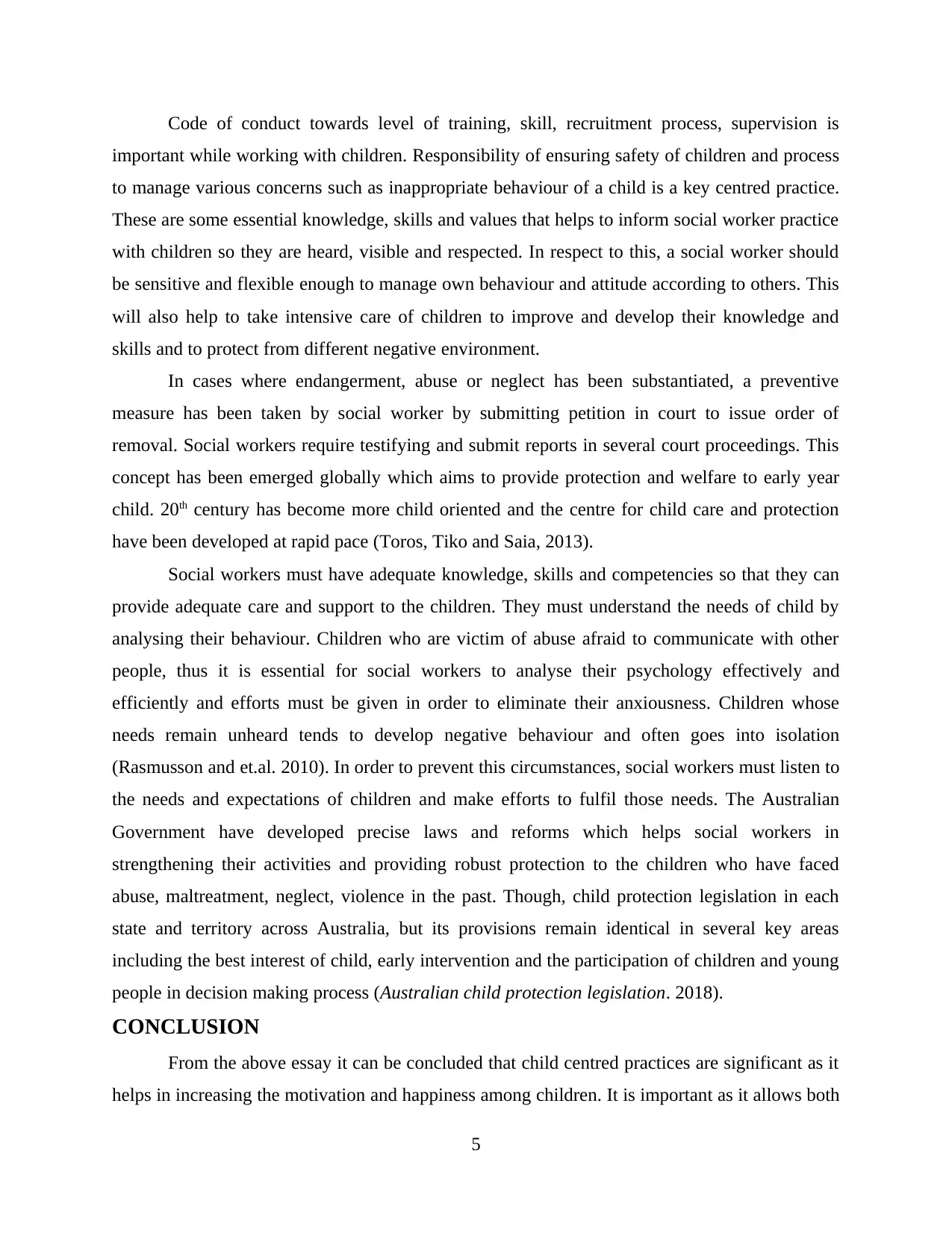
Code of conduct towards level of training, skill, recruitment process, supervision is
important while working with children. Responsibility of ensuring safety of children and process
to manage various concerns such as inappropriate behaviour of a child is a key centred practice.
These are some essential knowledge, skills and values that helps to inform social worker practice
with children so they are heard, visible and respected. In respect to this, a social worker should
be sensitive and flexible enough to manage own behaviour and attitude according to others. This
will also help to take intensive care of children to improve and develop their knowledge and
skills and to protect from different negative environment.
In cases where endangerment, abuse or neglect has been substantiated, a preventive
measure has been taken by social worker by submitting petition in court to issue order of
removal. Social workers require testifying and submit reports in several court proceedings. This
concept has been emerged globally which aims to provide protection and welfare to early year
child. 20th century has become more child oriented and the centre for child care and protection
have been developed at rapid pace (Toros, Tiko and Saia, 2013).
Social workers must have adequate knowledge, skills and competencies so that they can
provide adequate care and support to the children. They must understand the needs of child by
analysing their behaviour. Children who are victim of abuse afraid to communicate with other
people, thus it is essential for social workers to analyse their psychology effectively and
efficiently and efforts must be given in order to eliminate their anxiousness. Children whose
needs remain unheard tends to develop negative behaviour and often goes into isolation
(Rasmusson and et.al. 2010). In order to prevent this circumstances, social workers must listen to
the needs and expectations of children and make efforts to fulfil those needs. The Australian
Government have developed precise laws and reforms which helps social workers in
strengthening their activities and providing robust protection to the children who have faced
abuse, maltreatment, neglect, violence in the past. Though, child protection legislation in each
state and territory across Australia, but its provisions remain identical in several key areas
including the best interest of child, early intervention and the participation of children and young
people in decision making process (Australian child protection legislation. 2018).
CONCLUSION
From the above essay it can be concluded that child centred practices are significant as it
helps in increasing the motivation and happiness among children. It is important as it allows both
5
important while working with children. Responsibility of ensuring safety of children and process
to manage various concerns such as inappropriate behaviour of a child is a key centred practice.
These are some essential knowledge, skills and values that helps to inform social worker practice
with children so they are heard, visible and respected. In respect to this, a social worker should
be sensitive and flexible enough to manage own behaviour and attitude according to others. This
will also help to take intensive care of children to improve and develop their knowledge and
skills and to protect from different negative environment.
In cases where endangerment, abuse or neglect has been substantiated, a preventive
measure has been taken by social worker by submitting petition in court to issue order of
removal. Social workers require testifying and submit reports in several court proceedings. This
concept has been emerged globally which aims to provide protection and welfare to early year
child. 20th century has become more child oriented and the centre for child care and protection
have been developed at rapid pace (Toros, Tiko and Saia, 2013).
Social workers must have adequate knowledge, skills and competencies so that they can
provide adequate care and support to the children. They must understand the needs of child by
analysing their behaviour. Children who are victim of abuse afraid to communicate with other
people, thus it is essential for social workers to analyse their psychology effectively and
efficiently and efforts must be given in order to eliminate their anxiousness. Children whose
needs remain unheard tends to develop negative behaviour and often goes into isolation
(Rasmusson and et.al. 2010). In order to prevent this circumstances, social workers must listen to
the needs and expectations of children and make efforts to fulfil those needs. The Australian
Government have developed precise laws and reforms which helps social workers in
strengthening their activities and providing robust protection to the children who have faced
abuse, maltreatment, neglect, violence in the past. Though, child protection legislation in each
state and territory across Australia, but its provisions remain identical in several key areas
including the best interest of child, early intervention and the participation of children and young
people in decision making process (Australian child protection legislation. 2018).
CONCLUSION
From the above essay it can be concluded that child centred practices are significant as it
helps in increasing the motivation and happiness among children. It is important as it allows both
5
Paraphrase This Document
Need a fresh take? Get an instant paraphrase of this document with our AI Paraphraser
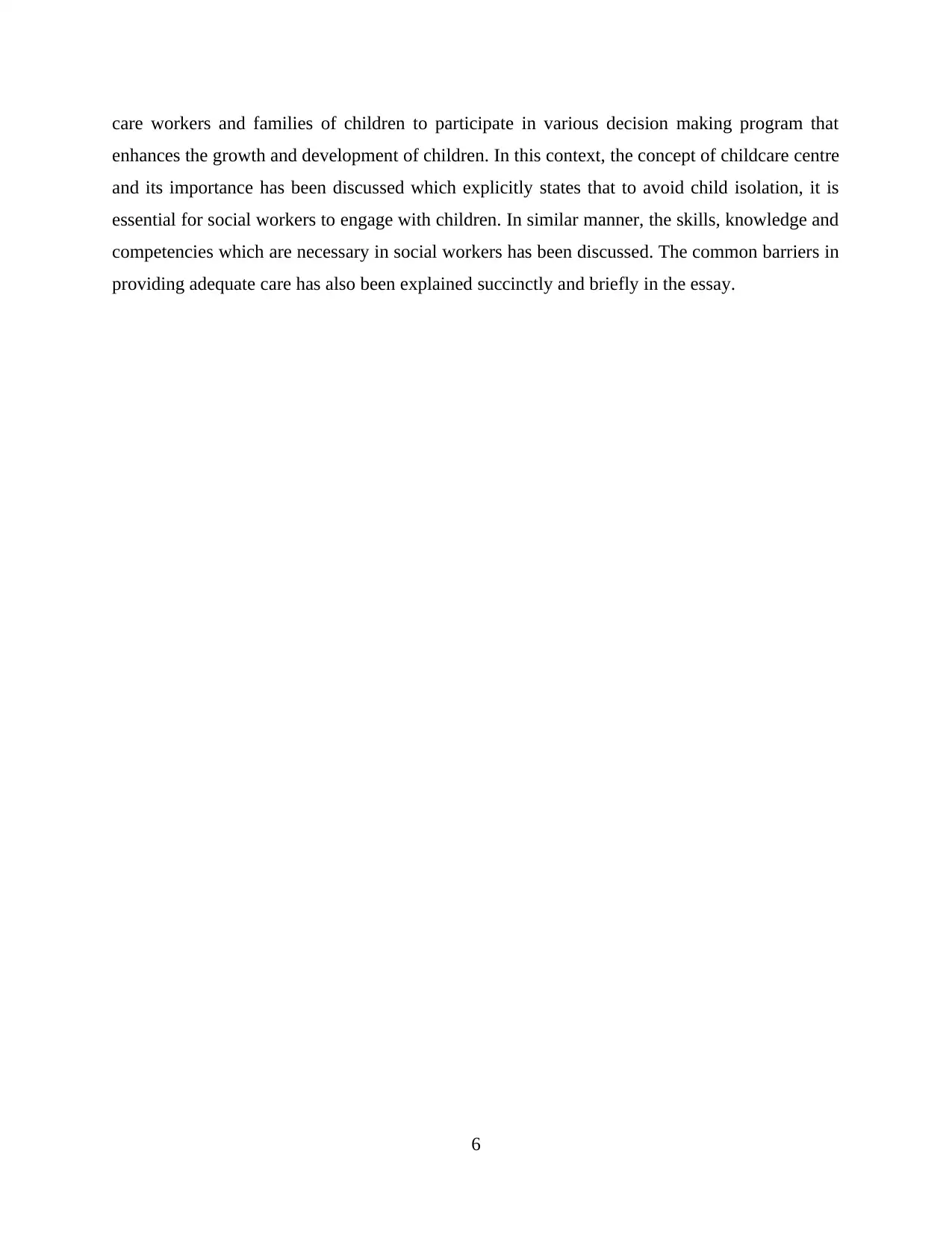
care workers and families of children to participate in various decision making program that
enhances the growth and development of children. In this context, the concept of childcare centre
and its importance has been discussed which explicitly states that to avoid child isolation, it is
essential for social workers to engage with children. In similar manner, the skills, knowledge and
competencies which are necessary in social workers has been discussed. The common barriers in
providing adequate care has also been explained succinctly and briefly in the essay.
6
enhances the growth and development of children. In this context, the concept of childcare centre
and its importance has been discussed which explicitly states that to avoid child isolation, it is
essential for social workers to engage with children. In similar manner, the skills, knowledge and
competencies which are necessary in social workers has been discussed. The common barriers in
providing adequate care has also been explained succinctly and briefly in the essay.
6
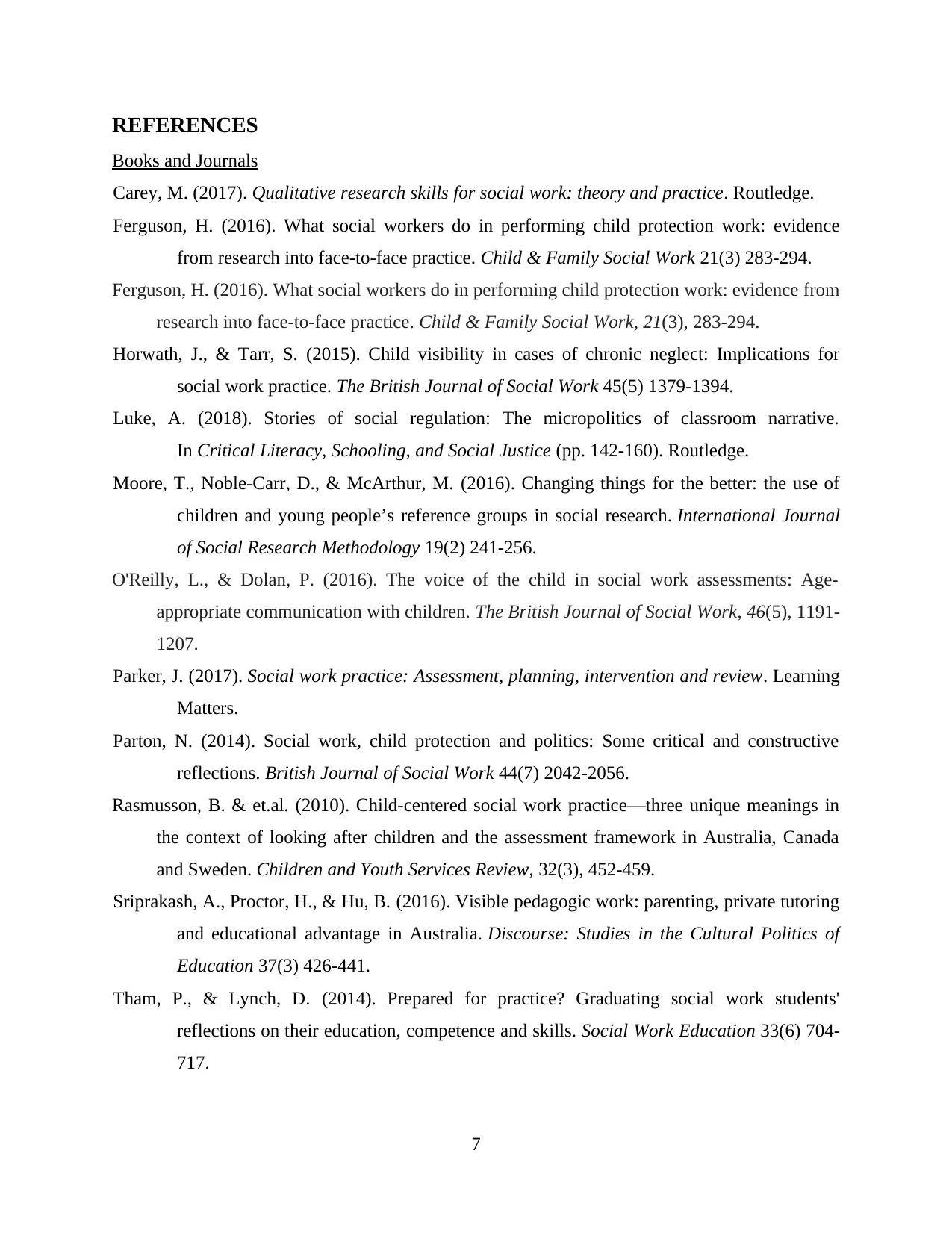
REFERENCES
Books and Journals
Carey, M. (2017). Qualitative research skills for social work: theory and practice. Routledge.
Ferguson, H. (2016). What social workers do in performing child protection work: evidence
from research into face‐to‐face practice. Child & Family Social Work 21(3) 283-294.
Ferguson, H. (2016). What social workers do in performing child protection work: evidence from
research into face‐to‐face practice. Child & Family Social Work, 21(3), 283-294.
Horwath, J., & Tarr, S. (2015). Child visibility in cases of chronic neglect: Implications for
social work practice. The British Journal of Social Work 45(5) 1379-1394.
Luke, A. (2018). Stories of social regulation: The micropolitics of classroom narrative.
In Critical Literacy, Schooling, and Social Justice (pp. 142-160). Routledge.
Moore, T., Noble-Carr, D., & McArthur, M. (2016). Changing things for the better: the use of
children and young people’s reference groups in social research. International Journal
of Social Research Methodology 19(2) 241-256.
O'Reilly, L., & Dolan, P. (2016). The voice of the child in social work assessments: Age-
appropriate communication with children. The British Journal of Social Work, 46(5), 1191-
1207.
Parker, J. (2017). Social work practice: Assessment, planning, intervention and review. Learning
Matters.
Parton, N. (2014). Social work, child protection and politics: Some critical and constructive
reflections. British Journal of Social Work 44(7) 2042-2056.
Rasmusson, B. & et.al. (2010). Child-centered social work practice—three unique meanings in
the context of looking after children and the assessment framework in Australia, Canada
and Sweden. Children and Youth Services Review, 32(3), 452-459.
Sriprakash, A., Proctor, H., & Hu, B. (2016). Visible pedagogic work: parenting, private tutoring
and educational advantage in Australia. Discourse: Studies in the Cultural Politics of
Education 37(3) 426-441.
Tham, P., & Lynch, D. (2014). Prepared for practice? Graduating social work students'
reflections on their education, competence and skills. Social Work Education 33(6) 704-
717.
7
Books and Journals
Carey, M. (2017). Qualitative research skills for social work: theory and practice. Routledge.
Ferguson, H. (2016). What social workers do in performing child protection work: evidence
from research into face‐to‐face practice. Child & Family Social Work 21(3) 283-294.
Ferguson, H. (2016). What social workers do in performing child protection work: evidence from
research into face‐to‐face practice. Child & Family Social Work, 21(3), 283-294.
Horwath, J., & Tarr, S. (2015). Child visibility in cases of chronic neglect: Implications for
social work practice. The British Journal of Social Work 45(5) 1379-1394.
Luke, A. (2018). Stories of social regulation: The micropolitics of classroom narrative.
In Critical Literacy, Schooling, and Social Justice (pp. 142-160). Routledge.
Moore, T., Noble-Carr, D., & McArthur, M. (2016). Changing things for the better: the use of
children and young people’s reference groups in social research. International Journal
of Social Research Methodology 19(2) 241-256.
O'Reilly, L., & Dolan, P. (2016). The voice of the child in social work assessments: Age-
appropriate communication with children. The British Journal of Social Work, 46(5), 1191-
1207.
Parker, J. (2017). Social work practice: Assessment, planning, intervention and review. Learning
Matters.
Parton, N. (2014). Social work, child protection and politics: Some critical and constructive
reflections. British Journal of Social Work 44(7) 2042-2056.
Rasmusson, B. & et.al. (2010). Child-centered social work practice—three unique meanings in
the context of looking after children and the assessment framework in Australia, Canada
and Sweden. Children and Youth Services Review, 32(3), 452-459.
Sriprakash, A., Proctor, H., & Hu, B. (2016). Visible pedagogic work: parenting, private tutoring
and educational advantage in Australia. Discourse: Studies in the Cultural Politics of
Education 37(3) 426-441.
Tham, P., & Lynch, D. (2014). Prepared for practice? Graduating social work students'
reflections on their education, competence and skills. Social Work Education 33(6) 704-
717.
7
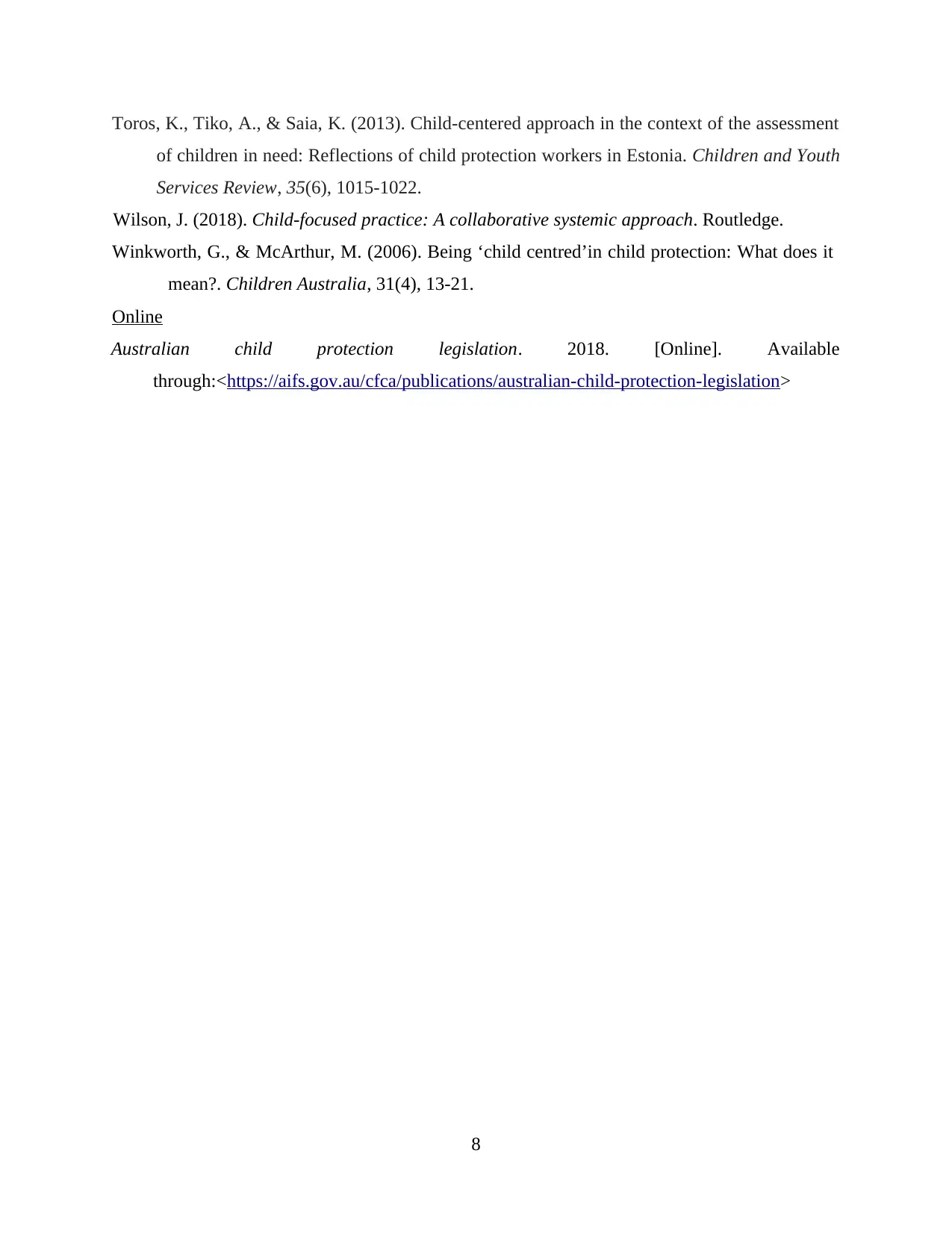
Toros, K., Tiko, A., & Saia, K. (2013). Child-centered approach in the context of the assessment
of children in need: Reflections of child protection workers in Estonia. Children and Youth
Services Review, 35(6), 1015-1022.
Wilson, J. (2018). Child-focused practice: A collaborative systemic approach. Routledge.
Winkworth, G., & McArthur, M. (2006). Being ‘child centred’in child protection: What does it
mean?. Children Australia, 31(4), 13-21.
Online
Australian child protection legislation. 2018. [Online]. Available
through:<https://aifs.gov.au/cfca/publications/australian-child-protection-legislation>
8
of children in need: Reflections of child protection workers in Estonia. Children and Youth
Services Review, 35(6), 1015-1022.
Wilson, J. (2018). Child-focused practice: A collaborative systemic approach. Routledge.
Winkworth, G., & McArthur, M. (2006). Being ‘child centred’in child protection: What does it
mean?. Children Australia, 31(4), 13-21.
Online
Australian child protection legislation. 2018. [Online]. Available
through:<https://aifs.gov.au/cfca/publications/australian-child-protection-legislation>
8
Secure Best Marks with AI Grader
Need help grading? Try our AI Grader for instant feedback on your assignments.

9
1 out of 11
Related Documents
Your All-in-One AI-Powered Toolkit for Academic Success.
+13062052269
info@desklib.com
Available 24*7 on WhatsApp / Email
![[object Object]](/_next/static/media/star-bottom.7253800d.svg)
Unlock your academic potential
© 2024 | Zucol Services PVT LTD | All rights reserved.





